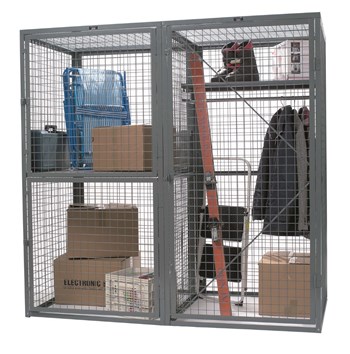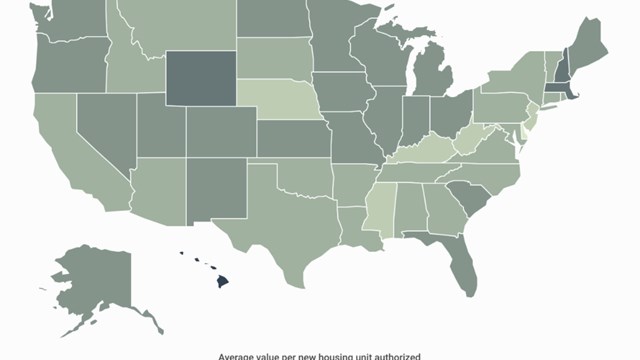
Without a doubt, storage space is a supreme luxury in New York City. With small living spaces selling at high prices abound, unit owners commonly require additional capacity for bikes, out-of-season clothing, suitcases, business files and other cluttering paraphernalia. While some buildings do not offer such space (other than in-unit closets), others do have a limited number of rentable storage units, shelves, and bike racks.
Indeed, Manhattan storage space is a seriously high-priced amenity. Earlier this year, a 35-square-foot space at 18 Gramercy Park. where a $42 million duplex was sold, was reported to sell for $75,000 (or $2,143 per square foot). Yikes! And, the storage spaces at 56 Leonard in Tribeca were selling between $72,000 for a 36-square-foot space and $300,000 for a combination storage unit measuring 211-square-feet; in another report, purchasing a storage unit at Midtown’s luxury One57 building starts at $101,000.
Most Desirable Amenity
“Storage units are more desired than gyms in most buildings,” says Josh Goldman, the president of Bargold Storage Systems in Long Island City, a company that retrofits building basements with steel storage locker facilities. “There are so many gyms in New York City but everyone wants to put their suitcases and alternate season clothing somewhere.”
Goldman claims he’s seen storage units made from mesh and solid steel construction, and some with just shelving and a barebones storage system in which management has simply drawn lines on a floor that delineate a resident’s space. “The residents are told that ‘this is your spot’ …but how long is it before they start to creep into other spots or in the aisles?” he says. “Some buildings have to get dumpsters and have the storage room cleared of stuff that’s not wanted anymore when apartments change hands.”
Frequently, finding additional storage space for residents represents a creative challenge. Paul Purcell, the managing director of William Raveis Real Estate in New York City, says one building on East 77th Street finds a solution by converting old maids’ rooms to storage units and selling them for $100,000 to $195,000. “Maids’ rooms are on separate floors and were typically 8-x-10 rooms with a sink and a toilet,” explains Purcell. “In the old days, people lived in them but today, they are used as offices and storage. One gentleman used it to hold his art collection.”
Recently, Purcell has helped one unit owner sell his $25 million apartment that included two storage spaces. The owner had them hermetically sealed and climate-controlled. “He used it to store wine and all sorts of things,” he says.
Jamie Barnard, the owner of Giant Industrial in College Point, testifies to buildings exerting maximum effort to find new spaces. “We’ve been asked to put storage units in all different places, including squeezing them in on top floors,” he says. “They really want to make money off every square inch they can. We sell outright to the co-op or condo and they, in turn, usually charge a fee on monthly maintenance and create revenue-producing storage rooms.”
Priced to Meet Demand
Not all building storage units are so incredibly pricey, though. Typically, rental prices for storage units run under $100 a month, and the price is included in monthly maintenance charges but in many buildings, the supply simply does not meet the demand.
“The size and type of storage units vary from building to building,” says Purcell, who once lived in Olympic Tower, a 51-story building with 225 units located between East 51st and 52nd Streets. “Storage styles run the gamut, from enclosed separate units with doors to wire cages. But, sometimes, the really large buildings, like the Olympic Tower that has 200-plus units, can’t accommodate a storage unit for each owner because there’s a limited amount of building space.”
Currently, Purcell resides in a prewar building with 55 units, and each unit includes a walk-in, floor-to-ceiling storage unit that is 5-x-6 or 9-x-10. “It’s wonderful,” he says. “Residents store overflow from their apartments like lamps, carpets, card tables, artificial Christmas trees, boxes with files, and more.” He emphasizes that storage spaces are an effective selling point, as well. “Logically, when I sell, the next person would get my unit, but in some buildings, residents vie for larger spaces.”
What You Can’t Store
According to Purcell, residents aren’t graded for storage unit neatness but they are forbidden to store flammable, and other potentially hazardous items, or anything that can cause mold. “You have to be sensible about what you’re storing,” he says. “But nobody goes around saying that yours should be tidier.”
Goldman states most storage units are pretty indestructible. “If there’s a situation where the super lost his key and had to break down the door, we go back and fix it,” he says. “We offer solid steel storage units, and we can both install it and manage it for them. Then we remit to them a percentage of the rent.” However, the biggest problem with storage units is the potential of water damage from leaky pipes. Barnard remembers Hurricane Sandy, which created a huge storm surge on October 29, 2012, flooding streets, subway tunnels, and building basements. “We rebuilt a fair amount of storage rooms after that…it was disastrous,” he said. “Typically, our material is powder-coated, so unless it really sat in water for an extended period of time, it will stand up to some weather conditions.”
Residents are responsible for insuring their own stored items. Goldman explains that steel storage units offer more privacy for the items, whereas wire mesh is less expensive but allows others to see items in storage.
Installation Costs
Once Goldman is contacted about an installation, he visits the empty space for an accurate measurement. “We submit a proposal to management with the sizes desired and how many units it will include,” he explains. “The units are typically the size of an elevator. Installation generally costs $1,000-$2,000 per unit, regardless of materials used. We have a meeting of the minds and agree upon the layout. The installation takes about a week per 10 units. We custom install per location, whereas some of the companies deliver panels that are put together like an erector set. Then we have an open house when the units become available.”
Since storage rooms are not accessed as often as laundry rooms, management often forgets about any maintenance or lighting the room may need. “Over time, there’s stuff in the aisles, lights go out, and the room needs attention, including painting, new locks, etc.,” says Goldman.
Barnard’s company provides wire mesh and solid enclosed units as well as bicycle racks for residential and commercial buildings. “When we’re called by management, we survey the basement space and then design and supply the storage units and bike racks,” he says. “We sell outright to the co-op or condo and they in turn usually charge a fee on monthly maintenance and revenue producing storage room.”
Barnard explains that a 200-unit building will probably have 20-30 assembled units, but each building is different. “It depends on the footprint of the building and its available space. By far, the most popular size of a unit is a 3-x-4 closet size. A 10-x-15 foot sized unit is the biggest residential one we’ve done so far. Now, we design storage units for new buildings during the design phase; it’s a tremendous revenue producer.”
Commonly, the units are made of mesh or 16-gauge solid sheet metal, which provides security. “If someone is going to break into it, they’ll break a lock, but we’ve installed thousands of units, and it is incredible the few callbacks we’ve had,” continues Bernard. “They are virtually maintenance-free unless there’s vandalism.”
“If we design a row that is going to be attached to a masonry wall, it’s a lot cheaper than if we have single units that need four sides in the middle of the floor,” says Barnard. “On average, the sizes are 3-x-5 and approximately $600 each. Within a day or two from when we are contacted we perform a site visit, then lay out pricing and it takes about 3 or 4 weeks to complete installation once we get the green light.”
Hey, I Need to Keep my Bike!
Unfortunately, not all items fit into storage units, including oversized items like kayaks and bicycles. “With the ‘greenification’ of New York, more residents are riding bicycles in New York City; we’ve installed 60,000 spaces since 1996, with most of them since 2000,” says Barnard, who has designed bike storage units for 55 Park Terrace East, and the Impala, a luxurious 31-story building. “We’ve built elaborate double-tier systems with proper overhead.”
To address the growing need for residents to store bicycles, the New York City Council passed the Bicycle Parking Text Amendment in 2009, which established regulations for multi-family residential buildings to require indoor, secure bicycle parking in new developments, substantial enlargements, and residential conversions; but waived it for residential buildings of 10 units or less. In the amendment, it states that 15-square-feet is required, per space, and must be enclosed and accessible, secured by a locked door, or must include a securely anchored rack to which the bicycle frame and one wheel can be locked. The text requires one bicycle parking space per two residential units. Bikes are now stored in bike rooms, equipped with hooks or stackers.
For residents who do not have storage units in the building, there are other opportunities available throughout New York City, including rentable off-property units. Another solution might be to purge, sell or donate unwanted items, freeing up space within your apartment.
Lisa Iannucci is a freelance writer and a frequent contributor to The Cooperator.






Leave a Comment